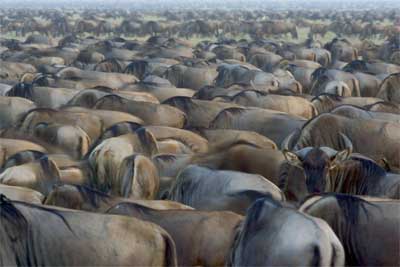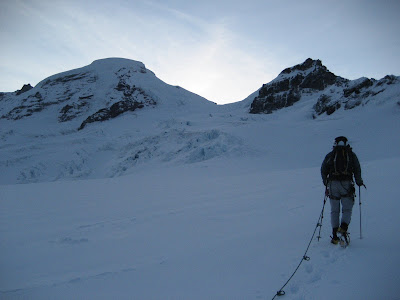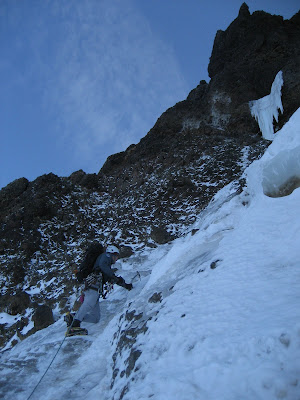
As a mountain guide people often ask me if I get bored of climbing certain routes. In Red Rock Canyon I’ve climbed Cat in the Hat (5.6+ II+) thirty or more times. I’ve climbed Solar Slab (5.6 III+) at least twenty times and in the Cascades I’ve summited Mount Baker twenty-nine times. So I know the routes very well, but do I get bored…?
The answer is no.
I don’t get bored because there’s always something interesting going on. Sometimes it’s an interesting person I’m climbing with. Sometimes it’s an interesting conversation. And other times an interesting event takes place on the route.
Sometimes the events that make a trip really memorable have little to do with those of us on the climb (like ash falling on a crag from a nearby forest fire), while other times they have everything to do with the climbers I’m with. Such was the case earlier this month.


Ian and Anne Marie were what I would call a normal climbing team. The young couple had a background that included a great deal of gym climbing and some outdoor single pitch work, but little multi-pitch experience. Upon meeting the two in the Red Rock Canyon National Conservation Area I suggested that we climb Geronimo (5.7 II+), a fun and laid back four-pitch route with big ledges and mild exposure. Little did I know that something extraordinary would happen at the top of the route on that beautiful fall day.
This season I’ve done Geronimo four or five times. Indeed, I’ve probably done it more than any other route in the canyon this fall. Geronimo requires a forty-five minute approach, so even on the busiest weekends the classic climb only sees a few parties a day. And though the route is notorious for stuck ropes on the descent, the lure of a quieter climb like this during the busy fall season is hard to ignore.


Geronimo has another interesting feature. It is perhaps the only route in the Conservation Area that has a summit register. A small rusty box is attached to the bolts on the summit with a tattered piece of webbing. Inside the box is a series of notes, photos and business cards. Most of the notes simply identify the members of the different climbing parties that sent the route.
We reached the summit after an enjoyable ascent. Both Anne Marie and Ian were excited to make the top since it was Anne Marie’s first real experience way off the deck and only Ian’s second.
We sat on the summit under the warm glow of Red Rock’s afternoon sun. Anne Marie lazily snapped photos of the steep craggy walls around us and the city in the distance. Ian dug through his backpack looking for something to eat.
Suddenly the young man had something in his hand. I struggled to see what it was. Everything became clear as he sunk to his knee and held a ring out to Anne Marie.
“Will you marry me?” he asked.



The young woman was thunderstruck. She stammered, tears shimmering in her eyes. “You’re not supposed to do that,” she whispered. “You’re not supposed to do that.”
Ian smiled and looked at me, “she hates surprises.”
“Not surprises like this,” she responded. “You’re not supposed to do that…”
Once I realized the gravity of the situation I took the camera from Anne Marie. I did so just in time.
The young woman whispered her mantra once more, “you’re not supposed to do that.”
“Does that mean yes?” Ian asked.

The newly engaged couple at the top of Geronimo.
Anne Marie looked up, her cheeks streaked with tears of happiness and said “yes.” She smiled, “yes, I will marry you.”
I frantically took photos of the happy couple as they kissed and then embraced one another. As they held each other, I realized that this would definitely be one of those days that I would remember.
The moment passed and all three of us were different in some way. Each of us were better people. The happy couple made a life-changing decision before me. And I am a better person for simply having witnessed it.

“We should write something in the summit register,” I said. The couple happily agreed.
I didn’t have a pen, so Anne Marie borrowed my knife and sliced a small piece of cardboard out of the ring box. She then carved a simple message into the cardboard. It read:
I Said Yes!
November 8, 2007




































